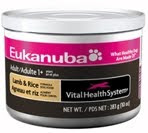 Our first stop was the neighborhood Walgreens. The Centrum vitamins, meant to replace essential nutrients Yo-Yo's kidneys were hell-bent on excreting before her body could absorb them, were easy to find. But the sodium bicarbonate eluded us even after a careful inventory of the shelves. So we went to find a pharmacist who clarified, "Oh, that's Alka Seltzer!" and accompanied us to the digestive remedy section of the store. None of us could find the bottle of pills described in the protocol, though. "Wait here a minute," the pharmacist said, then left to check the shelves behind the counter. "What amount should the pills be?" he asked when he returned. "10 grain," I confirmed from my printout. And then like a pirate showing off his treasure, he presented the 1,000-pill bottle.
Our first stop was the neighborhood Walgreens. The Centrum vitamins, meant to replace essential nutrients Yo-Yo's kidneys were hell-bent on excreting before her body could absorb them, were easy to find. But the sodium bicarbonate eluded us even after a careful inventory of the shelves. So we went to find a pharmacist who clarified, "Oh, that's Alka Seltzer!" and accompanied us to the digestive remedy section of the store. None of us could find the bottle of pills described in the protocol, though. "Wait here a minute," the pharmacist said, then left to check the shelves behind the counter. "What amount should the pills be?" he asked when he returned. "10 grain," I confirmed from my printout. And then like a pirate showing off his treasure, he presented the 1,000-pill bottle.In the crash course in blood chemistry and kidney function that Yo-Yo's Fanconi diagnosis has been, I've learned that floating around with the blood cells is sodium bicarbonate, a chemical necessary for regulating the acid level of a mammal's blood. Too acidic a level creates acidosis, a condition that causes irreversible cell damage and eventual organ failure. In the Fanconi-afflicted patient, the kidneys start dumping the sodium bicarbonate into the bladder where it is excreted prematurely, keeping the blood from the benefits of its neutralizing powers. By supplementing the dog with additional sodium bicarbonate [as many as 32 pills per day], the dog manages to retain enough of this important chemical, despite the insistence of the kidneys to usher it out of the body as speedily as possible. Who knew, Alka Seltzer in our blood!
 Our next stop was Petco, my least favorite of the pet supply stores but in the same shopping center as Walgreens. Here we braved smelly rodent cages to find the Pet-Tabs Plus and Pet-Cal, the canine-specific supplements on the protocol's list [the Pet Tabs smell so good that even though I am human, I'm tempted to try one myself]. The only problem was that the bottles were so dust covered that I wondered how long they had sat on the shelf.
Our next stop was Petco, my least favorite of the pet supply stores but in the same shopping center as Walgreens. Here we braved smelly rodent cages to find the Pet-Tabs Plus and Pet-Cal, the canine-specific supplements on the protocol's list [the Pet Tabs smell so good that even though I am human, I'm tempted to try one myself]. The only problem was that the bottles were so dust covered that I wondered how long they had sat on the shelf.  We decided to do things right and headed over to Pet Supermarket, my prefered pet supplier, for the purchase. Once there, however, we discovered that Pet Supermarket sold neither supplement. We found Pet Tabs, but I stubbornly insisted that since the protocol said Pet-Tabs Plus that I must have that type. Elizabeth, who was doing the driving, agreed to return to Petco where we purchased the dusty bottles.
We decided to do things right and headed over to Pet Supermarket, my prefered pet supplier, for the purchase. Once there, however, we discovered that Pet Supermarket sold neither supplement. We found Pet Tabs, but I stubbornly insisted that since the protocol said Pet-Tabs Plus that I must have that type. Elizabeth, who was doing the driving, agreed to return to Petco where we purchased the dusty bottles. Our last stop was a General Nutrition Center, which no longer sells the exact product mentioned in the protcol, Stack, an amino acid supplement for body builders. [Now it's called "Fuel."] As I certainly wouldn't pass for a Schwarzenegger wannabe, the clerk asked why I needed this supplement. I explained that the pills were for my dog, whose haywire kidneys were causing her to lose too much protein. "Oh, we get people buying stuff for their pets all the time!" he said. I guess a mammal is a mammal ...
Our last stop was a General Nutrition Center, which no longer sells the exact product mentioned in the protcol, Stack, an amino acid supplement for body builders. [Now it's called "Fuel."] As I certainly wouldn't pass for a Schwarzenegger wannabe, the clerk asked why I needed this supplement. I explained that the pills were for my dog, whose haywire kidneys were causing her to lose too much protein. "Oh, we get people buying stuff for their pets all the time!" he said. I guess a mammal is a mammal ... The other items in the protocl were dog food. One Fanconi syndrome story mentioned Innova as a good choice of food, especially because its probiotics reduced urinary tract infections. This food, however, is sold in "specialty boutiques," the closest one quite a drive from either home or work. I mentioned this brand when Dr. Skeptical, the specialist, was quizzing me, and she made a very good point: Don't buy food that would be difficult to get. She said that the lamb and rice Eukanuba, what Yo-Yo and Bug currently eat, qualified as good food. Since the specialist compound didn't have a whole wall devoted to a specific brand of dog chow, since no one attempted to suggestive sell anything to me [as do my regular vets], I decided that I could trust her advice and keep Yo-Yo on Eukanuba. I now add a scoop of low-fat Stoneyfield Farm yogurt as a way to get healthy bacteria into her.
The other items in the protocl were dog food. One Fanconi syndrome story mentioned Innova as a good choice of food, especially because its probiotics reduced urinary tract infections. This food, however, is sold in "specialty boutiques," the closest one quite a drive from either home or work. I mentioned this brand when Dr. Skeptical, the specialist, was quizzing me, and she made a very good point: Don't buy food that would be difficult to get. She said that the lamb and rice Eukanuba, what Yo-Yo and Bug currently eat, qualified as good food. Since the specialist compound didn't have a whole wall devoted to a specific brand of dog chow, since no one attempted to suggestive sell anything to me [as do my regular vets], I decided that I could trust her advice and keep Yo-Yo on Eukanuba. I now add a scoop of low-fat Stoneyfield Farm yogurt as a way to get healthy bacteria into her. The protocol also requires one can per week of mammal-based wet food as a way to replace long-chain amino acids. Pre-diagnosis, Yo-Yo already got a scoop of canned Eukanuba with every meal; now she gets a huge scoop. In addition, I make meatballs from beef and rice Nutro [more malleable than the Eukanuba wet] to get the sodium bicarbonate pills down.
The protocol also requires one can per week of mammal-based wet food as a way to replace long-chain amino acids. Pre-diagnosis, Yo-Yo already got a scoop of canned Eukanuba with every meal; now she gets a huge scoop. In addition, I make meatballs from beef and rice Nutro [more malleable than the Eukanuba wet] to get the sodium bicarbonate pills down. Since the protocl mentions that the Centrum is replacing "trace" vitamins and minerals lost in the deluge of urine, I also add a slice of roasted sweet potato, a scoop of canned pumpkin, or a pinch of broccoli sprouts [the most nutrient dense human foods I can think of] to her dinner.
Since the protocl mentions that the Centrum is replacing "trace" vitamins and minerals lost in the deluge of urine, I also add a slice of roasted sweet potato, a scoop of canned pumpkin, or a pinch of broccoli sprouts [the most nutrient dense human foods I can think of] to her dinner.Stories from basenji owners made the pilling sound like a difficult chore. They include ways to "trick" the dogs into taking the supplements. Yo-Yo, however, has balked at none of her new meds. The Pet Tabs and Pet Cals are flavored, and Yo-Yo will nose around the kibble seeking them out. I would require a huge gulp of water to swallow either the Centrums or amino acid supplements, but I just roll them in a dog food meatball, and Yo-Yo sucks them down in her happiness over extra wet. Mealtimes are more labor intensive, though. Gone are the days of a scoop of kibble and a scoop of canned. Now I have to assemble complicated bowls with more "courses" than any of my own dinners. So that Bug doesn't feel left out, I give him one Pet Tab per day, pill-less extra meatballs, the yogurt and sweet potato slices.


